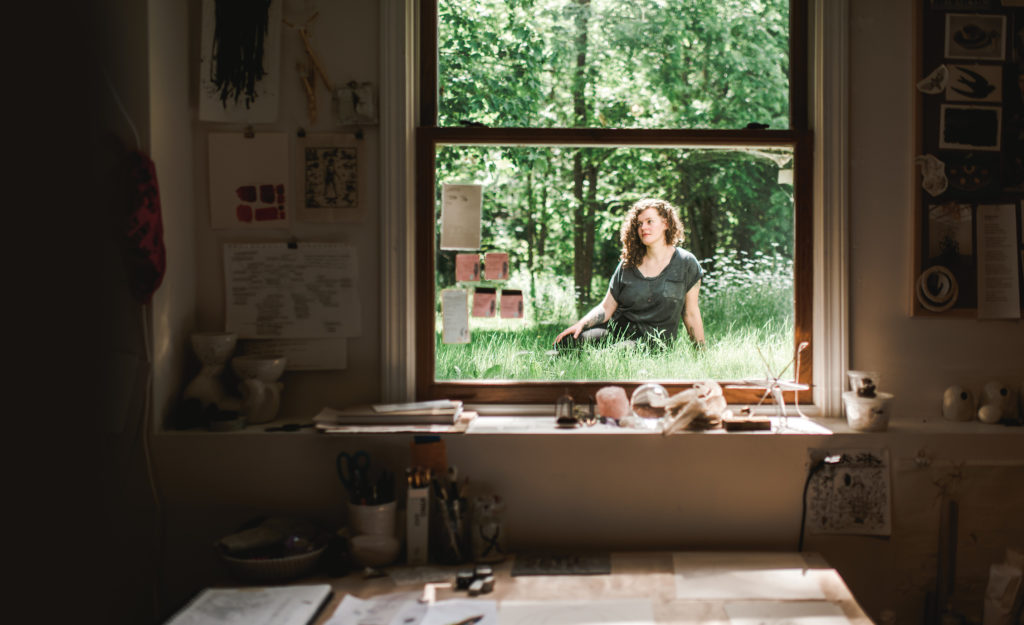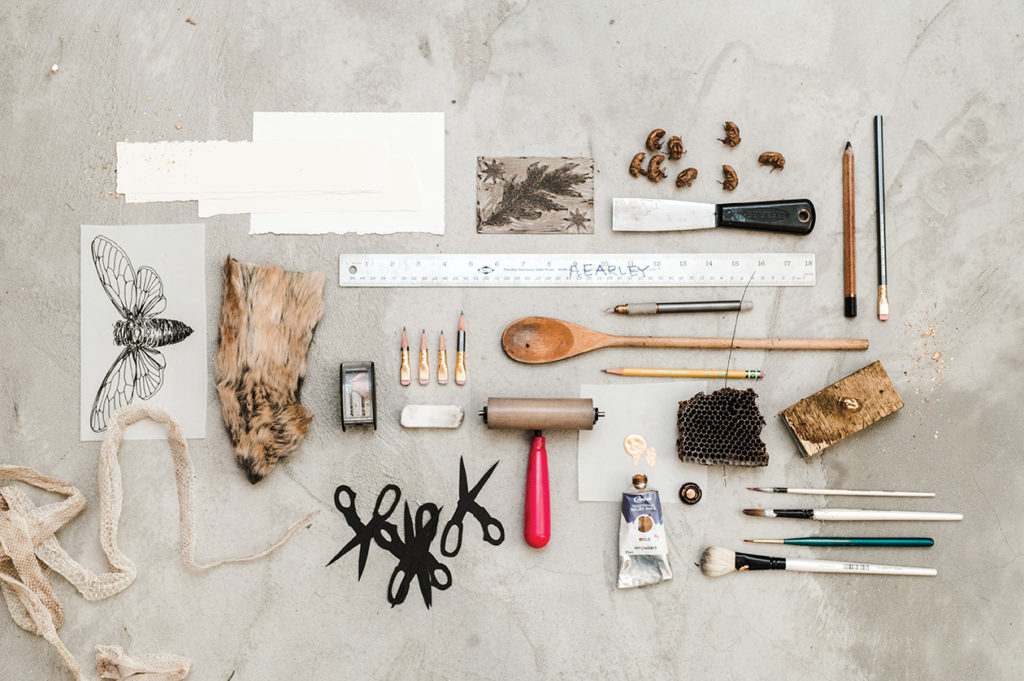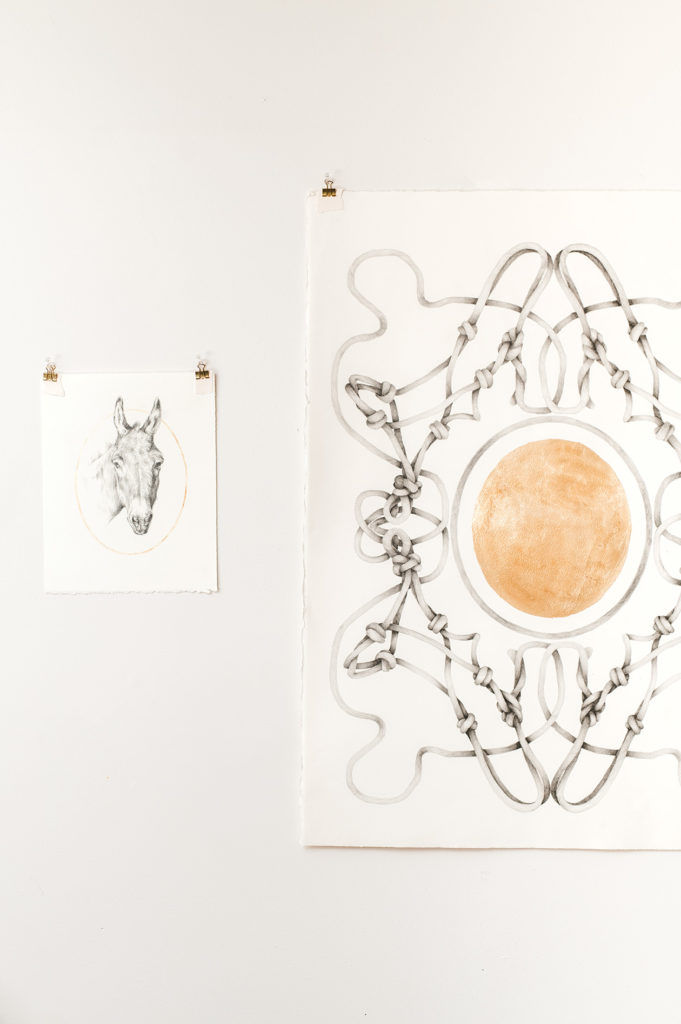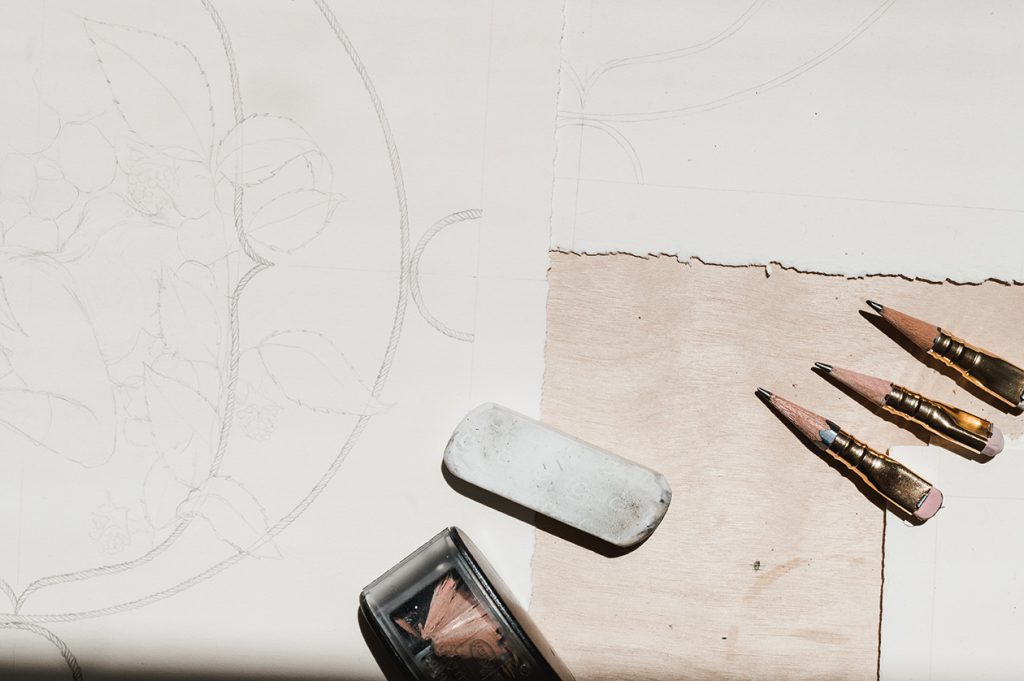The Durham Artist with a Penchant for Fairy Tales
Annika Earley, who manages Speedwell Projects in Portland, weaves folklore and magic into her artwork.

A hot early-summer breeze whips blossoms through the air in Portland’s Woodfords Corner neighborhood. Heavy afternoon traffic roars by, a skateboarder rattles down the sidewalk at full speed while peering into a phone, and a customer shouts a friendly ma’a salama as he leaves the busy halal market Foodie Friends. Across the hallway from the market, in the spacious glassed-in room directly below Charlie Hewitt’s now-iconic Hopeful sign, Speedwell Projects is a sanctuary of quiet and focus. Heavy glass doors and banks of windows keep out the noise and fill the art gallery with both light and seriousness. Artist Katarina Weslien’s photographic tapestries hang with a sense of silent urgency, and managing director Annika Earley sits at her desk, at the helm of this purposeful space.
Established in 2015 as a nonprofit gallery focusing on mid-career women who have devoted their lives to the arts, Speedwell Projects offers exhibitions, residencies, and public programming that work to correct imbalances of gender and age in the visual arts. Earley, a Swiss American artist who has a studio at her home in Durham, projects calm energy that is in harmony with the ethos of the gallery she joined in early 2021. Earley was previously codirector at the artist-run space Able Baker Contemporary, alongside Tessa Greene O’Brien. She applied for the position at Speedwell a few days before having her first baby, and she started the role a month and a half later. “It’s been a total whirlwind,” she says. There is a strong interconnectivity among her work at Speedwell, her work as a visual artist, and her work as a new mother, she says. A sense of sanctuary, power, and resourcefulness is key to these roles and is embodied in her rural life in Durham, where she has her studio in an unfinished space in her basement with large windows. (“Although right now I’m mostly working at the kitchen table,” she says.)

Earley’s tools, reference materials, and works in progress intersect in her orderly work space. 
Earley at work in her studio.
Growing up in Switzerland, in a small village near Basel called Zeiningen, has been a strong source of narrative for Earley’s artwork. During Fasnacht, a Swiss carnival that ushers in Lent, people embody the demonic by wearing grotesque, frightening wooden masks and engaging in transgressive activities such as raucous theatrical and musical performances that embrace chaos as a counterpoint to regulated domestic life. Earley grew up with this tradition, which merges the quotidian and the fantastic, and it shaped how she views the intersection of magic and daily life.
“I recently found an old newspaper clipping listing objects women have used to murder people with,” she says with a wry smile. “It was all of these kitchen tools and sewing tools and things they just had on hand. And in fairy tales, a lot of the magical objects are things that people just had around the house.” Finding weaponry in domestic objects offers escape for the women in these stories, giving them power and agency. Inspired by the resilience of folktales’ female heroes, Earley’s drawings, which depict partial figures moving through ornamented portals, embody a narrative in which the protagonist is both intensely vulnerable and capable of incredible transformation. In folktales women and girls are often asked to be quiet, complicit, and motherly, but instead find magical means of escape. Earley’s work, rendered in soft, dark pencil on small-scale white paper squares, shows us how radical that escape can be.

Darling and Love Is Worn Around the Neck are both from Earley’s Peau d’Ane series, which looks at Charles Perrault’s fairy tale Donkeyskin from the perspective of the resourceful female protagonist. 
Cloak, also from the Peau d’Ane series.
“I started drawing because I knew it would be flexible once I had the baby,” Earley says. “I can set them down, I can start them any time, and they’re also small…I can do them pretty much anywhere.” Drawing itself also functions as an escape from her daily life—a way of inhabiting the creative process and immersing herself in the world of the image. As a new mother who experienced a miscarriage before her recent pregnancy, Earley sees the life of the body as intimately tied to the life of the mind, and she says the pandemic has compounded the sense of constraint that comes from being tethered to physical needs. “There are a lot of things in the world right now where we need to find the exit door, and that fight-or-flight instinct is really strong for a lot of people,” Earley says. “We need more refuge, and more gentleness and tenderness in life. I want to escape to that.”

Immersing herself in her role at Speedwell is also part of her attempt to find refuge and freedom in creativity. Curatorial work comes naturally to Earley, who loves the process of hanging shows and seeing an artist’s vision materialize in the gallery’s space. Speedwell’s emphasis on women’s work is a thread that connects her studio and curatorial practices. “We really work to make space for women who have committed so much to their work and often get left out of the conversation,” she says. “We also include gender-fluid and nonbinary folks, because we want to correct a canon that has left so many people out.” This summer Rachel Gloria Adams—a Portland artist, designer, and mother—will be in residence at the gallery, with the freedom to inhabit her creative practice in an experimental way. As a place of both refuge and powerful activity, Speedwell embodies potential and visibility. As an artist, mother, and curator who is invested in the idea of refuge being a necessary condition for visionary action, Earley is guiding a community of artists into a space of sustained creativity.

Read more arts stories:
- The Immortal Life of Holly Meade

- “Beyond the Brick” Brings Maine-Made Art and Music to Life

- Watercolor Painter Abe Goodale Traces His Roots on 700 Acre Island

- Shifting Dynamics Through the Power of Theater


